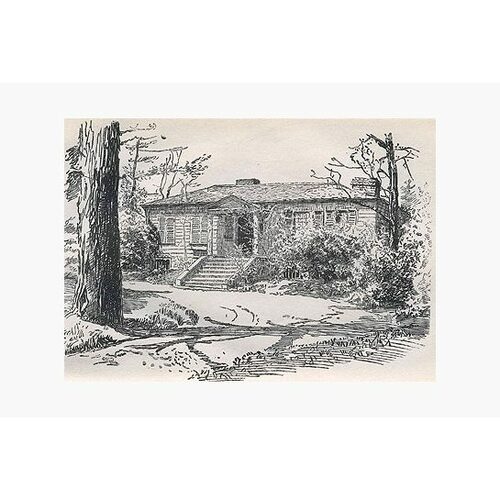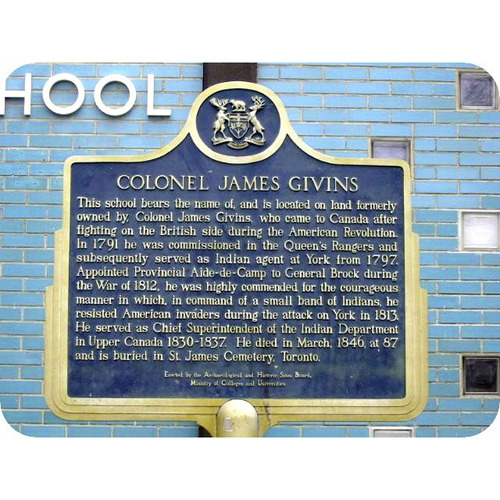
Source: Link
GIVINS, JAMES (early in his career he signed Givens), army and militia officer and Indian Department official; b. c. 1759, possibly in Ireland; m. Angelique Andrews in York (Toronto), and they had nine children; d. 5 March 1846 in what is now Toronto.
James Givins may have spent his early years in Ireland and was perhaps a relative of Henry Hamilton*, by whom he was “bred up” according to John Graves Simcoe*, lieutenant governor of Upper Canada. When Hamilton was appointed lieutenant governor of Detroit in 1775, young Givins accompanied him to the post. During his time there, he learned Ojibwa, an accomplishment that was to prove most useful in his later career. He was a volunteer in Hamilton’s attack on Vincennes (Ind.) in 1778. Taken prisoner when the Americans regained the settlement in 1779, he spent most of the next two years interned at Williamsburg, Va.
It is thought that Givins went to England following his release, but his movements for the next decade are unknown. Then, on 30 Nov. 1791 he was appointed lieutenant in the newly formed Queen’s Rangers, a corps raised to serve in Upper Canada and commanded by Simcoe. During the next several years he was engaged as a courier for confidential dispatches and as an interpreter for Simcoe in dealings with the Indians. He served in the British force sent west in 1794 during the period of international tension prior to the battle of Fallen Timbers [see Michikinakoua*].
As early as 1793 Simcoe had recommended Givins for a place in the Indian Department, and in June 1797 Administrator Peter Russell* named him assistant superintendent of Indian affairs for the Home District, an appointment that was finally confirmed in August 1798. He was to distribute the annual presents and to report on Indian “dispositions, movements, and intentions.” His prime responsibility, however, was to prevent Joseph Brant [Thayendanegea*] and the Six Nations from forming a pan-Indian organization that would include the Mississauga Ojibwas. Brant and Givins soon clashed openly. Brant charged that Givins was restricting Indian travel in Upper Canada and was purchasing land from the Mississaugas at less than market price. The dispute became so serious that Russell instructed Givins to visit Brant personally and make amends. An uneasy modus vivendi was arranged, but tensions between the two did not end until Brant’s death in 1807.
Following the disbanding of the Queen’s Rangers, on 19 Nov. 1803 Givins had been made a captain in the 5th Foot. He subsequently left the regiment but, with the outbreak of hostilities between Britain and the United States in June 1812, he returned to active military service. He was appointed a provincial aide-de-camp to Isaac Brock* on 14 August and was gazetted a major in the militia. Although he accompanied Brock to Detroit and subsequently fought on the Niagara frontier, his finest hour came on 27 April 1813 when, with a small company of Mississaugas, he assisted in the defence of York against the invading Americans. His “spirited opposition” was noted by the British commander, Sir Roger Hale Sheaffe*. After the close of the war his association with the militia continued. On 21 Jan. 1820 he was made colonel of the 3rd Battalion of York militia and the following year he was appointed colonel of the 1st Battalion of West York militia.
Givins’s greatest concern after 1814, however, was the Indian Department. With peace, the strategic military value of Indian warriors declined, while improved relations between Britain and the United States, financial retrenchment, and humanitarianism led the British government to adopt a new policy of “civilizing” the Indians. Givins was an early enthusiastic convert to one such experiment: he was instrumental in encouraging the Mississaugas and the Reverend Peter Jones* to establish a model village on the Credit River in what is now Mississauga, Ont. In 1828 when Henry Charles Darling, military secretary to Lord Dalhousie [Ramsay], conducted an inquiry into the state of the Indians, the success of the Credit Mission was noted, and the settlement ultimately became the example for the development of the reserve system.
In April 1830 the Indian Department in the Canadas was divided into two branches, with James Givins appointed chief superintendent for Upper Canada. Despite his advanced age and his requests for retirement, he continued in office until 12 June 1837, when he left the service on full pay. He died peacefully at his home, Pine Grove, nine years later.
MTRL, James Givins papers. PAC, RG 1, L3, 203: G1/33; RG 10, 10018, general order, 13 April 1830; A1, 5, Darling to Dalhousie, 24 July 1828; B8, 737. Corr. of Hon. Peter Russell (Cruikshank and Hunter). Corr. of Lieut. Governor Simcoe (Cruikshank). Select British docs. of War of 1812 (Wood). G.B., WO, Army list, 1794. Officers of British forces in Canada (Irving). R. S. Allen, “Red and white: the Indian tribes of the Ohio valley and Anglo-American relations, 1783–1796”
Cite This Article
John F. Leslie, “GIVINS (Givens), JAMES,” in Dictionary of Canadian Biography, vol. 7, University of Toronto/Université Laval, 2003–, accessed December 24, 2025, https://www.biographi.ca/en/bio/givins_james_7E.html.
The citation above shows the format for footnotes and endnotes according to the Chicago manual of style (16th edition). Information to be used in other citation formats:
| Permalink: | https://www.biographi.ca/en/bio/givins_james_7E.html |
| Author of Article: | John F. Leslie |
| Title of Article: | GIVINS (Givens), JAMES |
| Publication Name: | Dictionary of Canadian Biography, vol. 7 |
| Publisher: | University of Toronto/Université Laval |
| Year of publication: | 1988 |
| Year of revision: | 1988 |
| Access Date: | December 24, 2025 |




